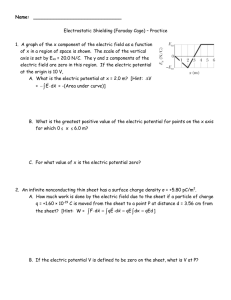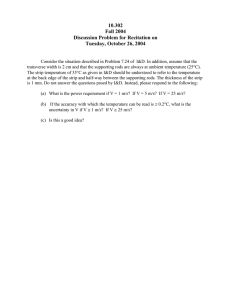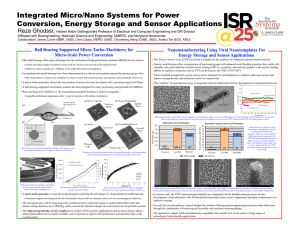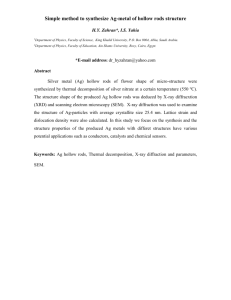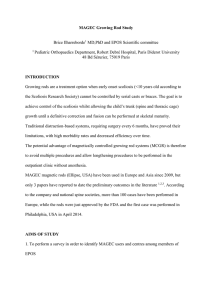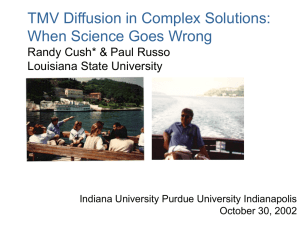North Carolina ACS Polymer Group, November 8, 2001
advertisement
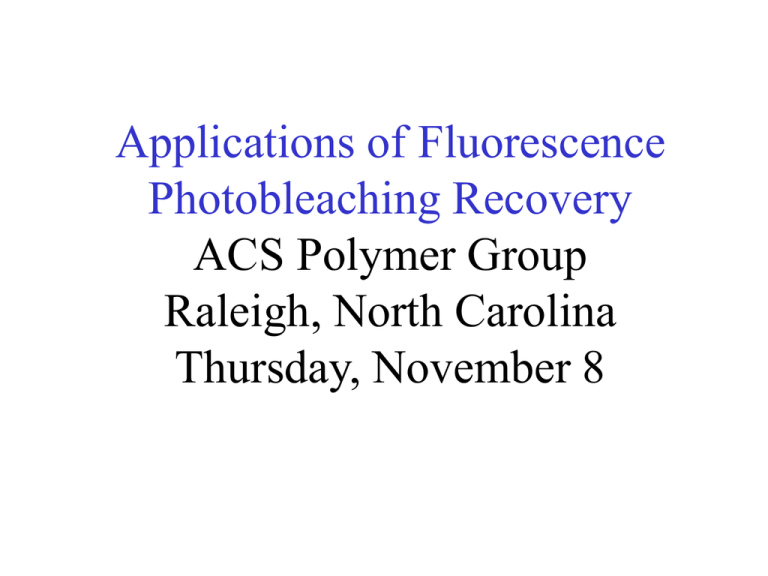
Applications of Fluorescence Photobleaching Recovery ACS Polymer Group Raleigh, North Carolina Thursday, November 8 Gelation of “sticky” rods O PBLG is “sticky” but not very. O PBLG: poly(benzyl-L-glutamate) Helical a-polypeptide backbone, persistence length > 1000 Å PSLG: a stickier wicket. PSLG: poly(stearyl-L-glutamate) O O Waxy Sidechains C18 = Stearyl Very rigid a-helical polypeptide backbone Intramolecular Hydrogen Bonds Why everyone cares about these molecules again. •Self-solvating (well, sorta): Molten Rods—easier processing. •Oriented Films/waveguides/chiral separation •Polymer Physics of Rods in Solution, Gel & Melt •More rigid and more soluble than those high-$$$ Air Force & NASA polymers •Hey…they don’t have to be rigid—helix-to-coil transition Idealized Rod Phase Diagram fa T ISO fb LC f Very rigid rods! Mw/Mn x= L/d fa (%) fb (%) favg (%) Onsager 4/x Flory 239,000 1.13 28 13.5 2 15.0 1.5 14.3 1 14 27 208,000 1.08 24 15.2 1.3 17.8 1.3 16.5 2.6 17 30 127,000 1.12 15 16.2 2.1 25.3 1.3 20.8 3.4 27 46 Mw by GPC/LS Hypothetical Rod Phase Diagram With Gelation Transitions Overlaid Iso LC S1 T S2 P1 LL2 LL1 P2 f DSC can detect ISO-LC transition. Heat per molecule gives no trend. sarah file: s.conave sarah file: s.conave 55 60 T m 50 T 55 H (mJ/mg PSLG) c 45 Temperature (C) 40 35 30 50 45 40 35 30 25 25 20 20 Ordered Isotropic 15 0 10 20 30 40 15 50 0 Weight % PSLG Schmidtke et al. Figure 4a 10 20 30 Weight % PSLG 40 50 Schmidtke et al. Figure 4b Annealing perfects but does not alter gel structure. Suggests motion! sarah file: s.annave 55 50 50 45 Temperature (oC) H (mJ/mg PSLG) sarah file: s.annave 45 40 35 40 35 30 30 25 0 100 200 300 400 Time cured (minutes) Schmidtke et al. Figure 5b 0 100 200 Time cured (minutes) 300 400 Schmidtke et al. Figure 5a Labeling Does Not Bug the Helix Computer Simulation Intrinsic Viscosity Static Light Scattering Dynamic Light Scattering Phase boundary determinations Temperaturedependent studies Modulation FPR Device PA TA/PVD PMT * OS * D S * M DM OBJ RR * M L AOM 20 700 Temperature-ramped modulation FPR 30 40 scan1062 combinehigh 50 2 DDSC 4 Contrast (AC/DC) 500 3 2040 s DSC start ramp @ 0.3oC/min 400 AC/DC DSC (W) or DDSC+600 ( W/ oC) 600 2 300 TRFPR: 30.7oC 200 1 1 Melt at 30.9oC 100 0 0 0 20 1000 2000 30 t (seconds) T/ oC 3000 40 Schmidtke et al. 50 Figure 6 Schmidtke et al. Figure 7 Everything can move, yet the structure remains Sticky rods—remaining challenges •Crosslink ‘em to lock in liquid crystal structure •Solution behavior above the gel transition •Rheological response •EM’s of these gels •Supercritical fluid drying of gels and LC’s Problems related to entanglement Bulk polymers: welding, processing, phase separation, failure Solutions: rate of dissolving, intracellular transport, separations for genomics, joining PVC pipe! Reptation—a theory to describe random snaking in polymer tangles There once was a theorist from France Who wondered how molecules dance. "They're like snakes," he observed, "as they follow a curve, the large ones can hardly advance."* D ~ M-2 deGennes Need: better diffusion methods Problem: lots of things appear to obey this scaling law Suggests: look at the ignored systems, especially RODS *With apologies to Walter Stockmayer Entanglement in solution? Collander To isolate spaghetti in "solution" with a fork is difficult: hydrodynamic interactions interfere with entanglement. After solvent is drained to obtain a "melt" the entire blob is easily handled. See, e.g., Lodge & Muthukumar, J. Phys. Chem. 1996, 100, 13275-13292 Our Hypothesis Solutions containing rodlike diffusers may provide evidence for entanglement-like phenomena in solution…or at least prove interesting, fun and challenging. Evidence would be: sudden drop-offs in mobility with concentration, failure to follow continuum mechanics. Rods should make effective probes. But very challenging: Early de Gennes paper on rod/coil diffusion: 19 citations Same era de Gennes paper on coil/coil reptation: 479 citations We may expect some problems! Why it’s worth it: composite precursor fluids, dissolution rate, phase sep’n rate, relation to GPC, CGE of rods, intracellular transport. Studying “entangled” rods by Optical Methods Fluorescently labeled probe rod Unlabeled rods Solvent Doi-Edwards-Onsager Reference Volumes for Rods = number density = # of rods per unit volume d LC formation * = 4/A2 5/dL2 L Reduced # Density /* dL2/5 2 3 dL L 1 3 L L3 1 A2 1 2 dL dL2 1 dL2 1 A2 A2 1 4 Desirable rod properties Stiff—no bending Monodisperse (all the same size) Non-aggregating Water-soluble We don’t have to make ‘em! Let mother nature do the work: plants make viruses (unwillingly) with most of these qualities. Doing our Part to Keep the “A” in LSU A&M Seedlings Sick Plants And close-up of mosaic pattern. Two TMV’s in Transmission Electron Microscopy An ear of corn has about as many kernels as TMV has protein subunits (ca. 2130). The protein subunits enfold a spiral-wound strand of RNA which will encode the next generation. TMV is more extended than an ear of corn. Better Views http://www.uct.ac.za/depts/mmi/stannard/linda.html TMV Characterization Sedimentation, Electron Microscopy & DLS Most TMV is intact. Some TMV is fragmented. weaker, faster mode in CONTIN decay analysis Intact TMV is easy to identify stronger, slower mode in CONTIN It is easy to measure at low concentrations that avoid TMV-TMV interactions in DLS and we can use small amounts in FPR after dye attached. Huh? Tobacco from the Carolinas to Connecticut If tobacco goes away… “Traditionally in Kentucky great mounds of brush are piled and burned in February to prepare a bed for tobacco seedlings. I remember spending most of the day hauling and piling brush. My dad would start the fire in late afternoon and we would sit up most of a cold February or March night stoking the fire, watching the stars, and roasting hot dogs or marshmallows over the bonfire. Many times neighbors would stop by and sit with us for a spell around the fire, talking into the night.” From: http://www.webcom.com/duane/farm2.html Measuring Translational Diffusion Modulation FPR Device a’la Lanni & Ware PA TA/PVD PMT * OS SCOPE * D S * M DM OBJ RR * M L AOM FPR Data for TMV Solution: very low dye content. Contrast 4 0.040 0.035 3 0.030 /Hz 0.025 0.020 0.015 2 0.010 DC Signal 0.005 0.000 0 2 4 6 8 10 12 14 K2 / 105cm-2 1 0 0 200 400 600 t/s 800 1000 Dtracer self of TMV vs. cTMV Source: Cush Monthly Report (5/1/01) 7 1/L3 1/dL2 5 4 3 D self / 10 -8 cm 2 s -1 6 2 1 0.1 1 10 c TMV / mg mL-1 100 Rotation & Diffusion of TMV in Polymer Solutions Matrix Polymer TMV Probe Solvent – – – Hard to see rotation in FPR; try scattering + + + Fabulous new autocorrelators for scattering 10 decades of time in one measurement! – – – Contrast for scattering stinks: everything scatters, esp. in aqueous systems where refractive index matching cannot hide matrix.
